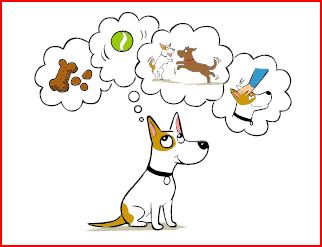Every day pet owners email me about problems they are having with their dogs—anxiety, aggression, unruly, lack of focus. One of the common themes with all of these scenarios is that these dogs tend to lack impulse control and their humans need to find better ways to provide guidance and leadership.
Fortunately, humans can develop the needed communication skills while training dogs to have self-control and emotional control in one fun, reward-based program called the Learn to Earn Program. In this program, humans gain leadership by controlling all the resources that motivate the pet and requiring the pet willingly work for these items instead of getting them for free. Now, the focus is on using all valued resources to reward desirable behaviors while simultaneously removing the rewards for undesirable behavior.
This overall approach has been called nothing in life is free, no free lunch, or the learn-to-earn program. Each behavior consultant has his or her own variation. The following presentation is my own version of the Learn to Earn Program for Developing Leadership in Humans and Impulse Control in Dogs. The actual program is laid out step-by-step with photos in Perfect Puppy in 7 Days (chapter 5). This blog is part of a 3-part blog that highlights the most important points of my Learn to Earn plan.
Overview
Say Please by Automatically Sitting is the Foundation Behavior
In this Learn to Earn program, the idea is to use everything your dog wants to your advantage as rewards for training purposes.The dog will learn to earn everything she wants by politely and automatically saying please by sitting. She will at the same time, learn that performing undesirable behaviors such as jumping on you cause the potential rewards for those behaviors to go away.
For the fastest training, dogs should earn their meal throughout the day when you are home. That means no food in the food bowl. Instead, you’ll carry food around with you in your pockets, in a bait bag, or have it available in easily accessible containers throughout the house. Then, throughout the day, when you are home, you’ll reward appropriate behavior.
How the Learn to Earn Program Trains Leadership and Communication Skills in Humans.
This program consists of setting clear rules for the dog to automatically sit for all resources. The human learns to communicate the rules by immediately (i.e., within 0.5 seconds) reinforcing correct behaviors as they occur, and preventing the dog from receiving rewards for undesirable behaviors. So a large part of this program is teaching owners the exact body movements and timing that help them convey a clear message.
Leadership is established when humans can set clear guidelines for the dog’s behavior and can effectively communicate the rules by always rewarding correct behaviors as they occur while preventing or immediately removing the rewards for undesirable behaviors before they are accidentally reinforced. The owner must stick to this plan long enough for the good behaviors to become a habit.
When owners can meet these criteria, their dog learns to view them as consistent, predictable, and able to guide. Alternatively, when rules change randomly the dog may view the owner the same way you might view a boss who keeps changing his mind. Overall with the Learn to Earn Program, rather than complying out of fear, dogs can choose to follow human direction because doing so leads to rewards and then doing so becomes a habit. This model reflects a good understanding of the underlying cause of improper canine behavior and leads to a stronger dog–owner bond.
How the Learn to Earn Program Leads to Self Control in Dogs.
In general, dogs have impulse control issues because taking things without asking, barging through the door, blurting out of turn, and pulling with all their might have worked so well in the past. For some dogs and breeds of dog there may be a physiologic or genetic tendency towards having less impulse control, which means their humans must carry out the program more thoughtfully and consistently than owners of the average dog.
In this program, we turn the house rules onto their head. Whereas taking things without asking worked before, the only thing that works to get them what they want now is to automatically say please by sitting. We start with easy situations such as requiring dogs to sit for treats or kibble delivered by hand. This way we can quickly build up a high rate of reinforcement leading to a faster rate of learning. Next, we systematically work with more difficult situations such as sitting to play fetch or for the opportunity to chase squirrels and then we expect longer or more bouts of desired behavior for fewer and fewer rewards.
The Benefits: How the Program Changes Your Dog’s Perspective
Because dogs learn that the only way they can get what they want is by sitting and looking to you for permission, the learn to earn program teaches them to control their emotions (self-control) even if that means remaining calm in order to:
- get attention from you or whatever they want most.
- that paying attention to you, your words, signals, and guidance are important because it gets them what they want.
- when faced with a difficult situation, they can and should look to you for guidance.
Consequently, the Learn to Earn program is useful for dogs with fear, anxieties (including separation anxiety), arousal issues or hyperactivity, inability to focus on their owners, as well as just general lack of training and unruly behavior.
Why training during all interactions throughout the day and for all resources, including all of their food, is important.
This training throughout the day and for all resources, including each kibble, may seem a huge inconvenience but doing so will make a huge difference. Here’s why we do it.
- So your dog will develop a habit rather than a trick: If you only train in specified sessions, your dog may just learn to behave during those training sessions. The things you do at the start of such sessions, such as pulling out a treat bag or placing a special collar or leash on, will become the cues to behave for just that short time rather than behaving well all the time. Then, if on top of that you add other resources such as petting, attention, and play when she wants these things, you’ll increase your toolbox of rewards even more. Add to this removal of all rewards for undesirable behavior and now you have a formula for changing the dog’s behavior patterns virtually overnight (meaning days to weeks instead of weeks to years).
The necessity and benefits of tethering your dog to you at first.
In the first days of training your dog should be tethered to you on leash at all times when you are at home and she isn’t in her crate or pen, dog-safe room, or tethered to an object near you. When she’s not tethered to you, she specifically needs to be in some type of situation where she can’t practice unwanted behaviors, such as barking, pacing, and others that reinforce poor impulse control. Tethering to you is especially important because:
- If your dog’s near, it’s easier to reward good behaviors as they occur. Otherwise, you tend to forget and miss opportunities, which makes training take weeks or months longer.
- Because she’s supervised, it’s difficult for her to practice or perform unwanted behaviors.
- Tethering to you teaches your dog that when she doesn’t want to pay attention to you, she can’t just blow you off, walk away, and then get rewarded by something else, such as a dropped food wrapper that she grabs. That is, tethering her to you helps prevent rewards for undesirable behavior.
I use a Buddy System hands free leash (www.buddysys.com) for the tethering to me or to furniture. I keep my dog on a regular flat buckle collar or on a harness that hooks to the front such as the WalkinSync®, Freedom Harness® or Gentle Leader® Harness.
How long to continue the plan.
Some people assume they’ll have to continue this intense program forever. The reality is that if humans work at this diligently their dogs will progress more in a week than most dog-human teams learn in many months. But just so you have an idea of how long you will go.
Continue the complete indoor program including tethering:
- In general, a dog should stay on this tethering stage until she readily and automatically quickly sits when she wants something—food, attention, to go out the door, etc—and also has a 100% come when called the first time you call even when there are distractions in the house. To develop that 100% come when called you will go through stages where the dog is dragging a long leash so you can specifically work on come.
- For most problem dogs that I work with in my house, this takes just several days or at most a week. For more difficult dogs this stage may last much longer (3–4 weeks for me which means much longer for you).
Continue the sit for everything: Until you have the perfect dog that you want. Remember that impulse control in one situation will affect arousal and control in another. So that if our dog goes bonkers over squirrels and over tennis balls, say please by sitting in order to play fetch is important for getting him to behave well around squirrels too.
To download the free poster on The Learn to Earn Program from our store for free or a donation, click here.










